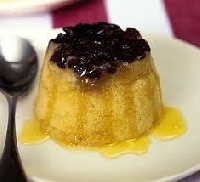An 1816 pudding recipe
Launch gallery slideshow

| Group: | "At Home with the Georgettes" |
| Swap Coordinator: | Star7Lily (contact) |
| Swap categories: | Email Food Handmade |
| Number of people in swap: | 4 |
| Location: | International |
| Type: | Type 1: Electronic |
| Last day to signup/drop: | January 27, 2023 |
| Date items must be sent by: | February 17, 2023 |
| Number of swap partners: | 2 |
| Description: | |
|
Ladies and Gentlemen, For our first swap of the year, we shall make a genuine Regency desert pudding that will grace any table with its stylish shape, for we are to use a ceramic mould or bowl for the pudding, and a jelly mould for the custard. We intend to share our cooking findings with our partners. Yes, this time we shall have two partners to share our culinary journey, please be willing to share any disappointments in the taste or making department, your thoughts on the flavours of the turn of the 19th century, and enjoy the merriment with each other So send an email to two partners, containing your description of how it was to make this recipe, how easy or otherwise, what you (and your family) thought of the presentation and grand tasting. Please include photographs of your Regency 1816 pudding and its accompanying custard. May you have a rewarding day in the kitchen. Jane, Anna and Nickalli. 1816 CARROT PUDDING Receipt1 breakfastcupful of each:- grated carrot, milk, suet, breadcrumbs, currants, raisins, flour Point to remember: The carrot is grated and added raw. for your convenience I have added more instructions in italics. to prepare for steaming- push the butter paper (or buttered baking parchment) onto the surface of pudding, touching it all around the sides aswell. Cut a piece of cloth eg from old sheet, to cover around the open mouth of the pudding bowl (metal or china bowl) extending down the sides a little way, tie it on tightly around the lip of bowl with string. Next tear a piece of aluminium foil folded up in quarters & place in bottom of a larger saucepan for boiling (this stops burning the bottom of pudding basin), next fill saucepan to half way up the outsides of bowl with water. place on saucepan lid firmly *bring to the boil, then turn heat down to simmer for 8 hours, do not let the water get too low, top up to half way up the sides every two hours or so. Jesmond Custard 3 leaves of gelatin (they used isinglass, but gelatin is our substitute)
3 eggs, half a breakfastcupful of fine sugar, Two and half breakfastcupful milk. PLEASE NOTE: Natron is the common name for a natural salts rising agent, used extensively in Europe & Africa where it originates, in USA it is known as Sodium bi-carbonate, in UK & Australia it is known as Bi-carbonate of Soda. It has been used for many centuries in baking, and four millennia in cleaning and hygiene. It is completely safe. If you do not know what SUET is, "Suet is the raw, hard fat of beef" what we generally cut away...you can use a replacement if it is unavailable such as lard where you buy butter alternatives in refrigerator section in supermarkets, lard is made from pork fat or a modern alternative is vegetable shortening. Suet maybe sold boxed in the bakery section of your supermarket, or British food store. But if all else fails, then use frozen butter. | |
Discussion
Leave a Comment
You must be logged in to leave a comment. Click here to log in.
- Info:
- Home
- |
- About
- |
- Forum Rules
- |
- Terms of Use
- |
- Press
- |
- Advertising
- |
- Blog
- |
- Graphics & Stuff
- Help:
- New User Info
- |
- FAQ
- |
- Group Info
- |
- Glossary
- |
- Forums
- |
- |
- Contact Admin

